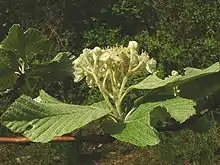Whitebeam
The whitebeams are members of the family Rosaceae, comprising subgenus Aria (or, according to some authorities, its own genus) of genus Sorbus, and hybrids involving species of this subgenus and members of subgenera Sorbus, Torminaria and Chamaemespilus. They are deciduous trees with simple or lobed leaves, arranged alternately. They are related to the rowans (Sorbus subgenus Sorbus), and many of the endemic restricted-range apomictic microspecies of whitebeam in Europe are thought to derive from hybrids between S. aria and the European rowan S. aucuparia; some are also thought to be hybrids with the wild service tree S. torminalis, notably the service tree of Fontainebleau Sorbus latifolia in French woodlands.
| Whitebeam | |
|---|---|
 | |
| Common whitebeam flowers | |
| Scientific classification | |
| Kingdom: | Plantae |
| Clade: | Tracheophytes |
| Clade: | Angiosperms |
| Clade: | Eudicots |
| Clade: | Rosids |
| Order: | Rosales |
| Family: | Rosaceae |
| Genus: | Sorbus |
| Subgenus: | Sorbus subg. Aria Pers. |
The best known species is the common whitebeam Sorbus aria, a columnar tree which grows to 25 m (82 ft) tall by 10 m (33 ft) broad, with clusters of white flowers in spring followed by speckled red berries in autumn (fall).[1]
Appearance
The surface of the leaf is an unremarkable mid-green, but the underside is almost white (hence the name) transforming the appearance of the tree in strong winds, as noted by the poet Meredith: "flashing as in gusts the sudden-lighted whitebeam".[2] It is also described as the "wind-beat whitebeam" in Gerard Manley Hopkins' poem "The Starlight Night".[3]
Ecology
The berries are a favourite of birds, though less palatable (drier, less juicy) than rowan berries. Whitebeams are sometimes used as larval food plants by Lepidoptera species, including the short-cloaked moth.
Uses

These trees are often grown in parks and large gardens. The cultivars S. aria 'Lutescens'[4] and S. aria 'Majestica' have gained the Royal Horticultural Society's Award of Garden Merit.[5]
The tough, hard wood is a deep orange when wet, and pale yellow after drying.
The berries are edible and are often made into jelly.
Classification
- section Aria - Sorbus aria and its close relatives
- section Alnifoliae - a group of Asian species
- section Thibeticae - a group of species from the Himalayas and southern China
- Sorbus intermedia group (nothosubgenus Soraria) - taxa of hybrid origin involving sections Aria and Sorbus
- Sorbus latifolia group (nothosubgenus Tormaria) - taxa of hybrid origin involving sections Aria and Torminaria
Selected species
Sorbus subgenus Aria
- Sorbus admonitor - No parking whitebeam
- Sorbus alnifolia - Korean whitebeam
- Sorbus anglica - English whitebeam
- Sorbus aria - Common Whitebeam
- Sorbus aronioides - Chokeberry-leaved whitebeam
- Sorbus arranensis - Arran whitebeam
- Sorbus austriaca
- Sorbus bristoliensis - Bristol Gorge whitebeam
- Sorbus cambrensis - Welsh whitebeam
- Sorbus carpatica - Carpathian whitebeam
- Sorbus cheddarensis - Cheddar whitebeam
- Sorbus croceocarpa - Orange whitebeam
- Sorbus cuneifolia - Llangollen whitebeam
- Sorbus danubialis
- Sorbus decipiens - Sharp-toothed whitebeam
- Sorbus devoniensis - Devon whitebeam
- Sorbus eminens - Round-leaved whitebeam
- Sorbus eminentiformis - Doward whitebeam
- Sorbus eminentoides - Twin Cliffs whitebeam
- Sorbus folgneri - Folgner's whitebeam
- Sorbus franconica
- Sorbus graeca - Balkan whitebeam
- Sorbus hemsleyi
- Sorbus hibernica - Irish whitebeam
- Sorbus hybrida - Finnish whitebeam, Swedish service-tree
- Sorbus intermedia - Swedish whitebeam
- Sorbus lancastriensis - Lancastrian whitebeam
- Sorbus latifolia - Service tree of Fontainebleau
- Sorbus leighensis - Leigh Woods whitebeam
- Sorbus leptophylla - Thin-leaved whitebeam
- Sorbus leyana - Ley's whitebeam
- Sorbus margaretae - Margaret's whitebeam
- Sorbus minima - Least whitebeam
- Sorbus mougeotii - Vosges whitebeam
- Sorbus parviloba - Ship Rock whitebeam
- Sorbus porrigentiformis - Grey-leaved whitebeam
- Sorbus pseudofennica - Arran service tree
- Sorbus pseudomeinichii - False rowan
- Sorbus rupicola - Rock whitebeam
- Sorbus rupicoloides - Gough's Rock whitebeam
- Sorbus saxicola - Symonds Yat whitebeam
- Sorbus scannelliana - Scannell's whitebeam
- Sorbus stenophylla - Llanthony whitebeam
- Sorbus stirtoniana - Stirton's whitebeam
- Sorbus subcuneata - Somerset whitebeam
- Sorbus thibetica - Tibetan whitebeam
- Sorbus umbellata
- Sorbus vestita - Himalayan whitebeam
- Sorbus vexans - Bloody whitebeam
- Sorbus whiteana - White's whitebeam
- Sorbus wilmottiana - Wilmott's whitebeam
Plus many other species
- Sorbus subgenus Sorbus
- Sorbus Other subgenera
References
- RHS A-Z encyclopedia of garden plants. United Kingdom: Dorling Kindersley. 2008. p. 1136. ISBN 978-1405332965.
- Meredith, G. (1851). Love in the valley. Line 207. Poems
- Hopkins, Gerar Manley (1918). The starlight night. Line 6.
- "RHS Plant Selector - Sorbus aria 'Lutescens'". Retrieved 4 June 2013.
- "RHS Plant Selector - Sorbus aria 'Majestica'". Retrieved 4 June 2013.
